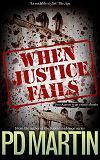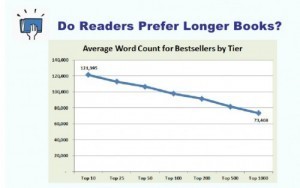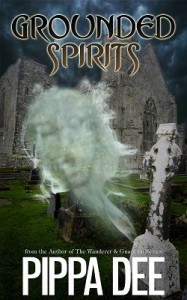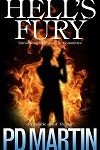P.D. Martin's Blog, page 6
June 21, 2012
Where’s the sweet spot?
One ebook tip is to experiment with pricing and that’s what I’m doing at the moment. There seems to be a few common price points for self-published ebooks, namely:
Free (ahhh!!!)
$0.99
$2.99
$3.99
$5.99
A friend recently forwarded me a great graph that was presented by Smashwords founder Mark Coker. Admittedly, for most authors sales from Smashwords make up an incredibly small percentage compared to Amazon sales, but it’s still interesting to look at this data.
So it seems the sweet spots are hitting at $0.99, $2.99 and another small spike at $5.99. Interesting, huh?
I noticed from Brett Battle’s post that my pricing points seem to be in sync with his for the most part, with shorts at $0.99, my one novella at $2.99 and my full thriller novel at $3.99. But, when I released my Pippa Dee books (YA and much shorter than my thriller novel at 50,000 words) I priced them at $2.99. I thought this seemed fair. Reasonable. Attractive but without de-valuing my work.
However, these books simply haven’t been moving. Was it the new name? Establishing a new brand? Possibly. Or the genre? While they’re books I believe most adults would read and enjoy (and they have), they have teen protagonists and so that ‘officially’ makes them targeted to the middle grade and YA market. Maybe not a good market for ebooks? So as part of my experimentation I’ve lowered the price to $0.99. I should say, this move to the $0.99 was partly because of the above graph, and partly because I have a friend who’s doing well in the ebook business and has priced ALL her books at $0.99. She felt that low price point was a key part of her strategy to build her brand and name. I only reduced the prices a few days ago so it’s too early to tell if this strategy will work or not. But it means I have been thinking of ebook pricing a lot recently and wanted to post about it here, too. Here are the two for $0.99, by the way.
So, what do you like to pay for your ebooks? Maybe the graph above reflects your buying patterns too. Note: I actually asked what people like to pay for ebooks on Facebook and, incredibly, got answers around the $5-10 mark. Then again, I posted during Aussie daytime and so I think all the respondents were Aussies—who are used to paying a fortune for books!
June 6, 2012
Dialogue woes
I’m currently working on a novel set in Ireland. I’d like to give the reader an idea of the Irish accent without confusing them.
Now, here’s the thing. I know most books on writing say NOT to actually write in a character’s slang or accents (or to do so very sparingly). And when I’m teaching dialogue, this is the guideline I suggest budding writers follow. But now I’m going against that advice and actually writing the accent. So I need your help 
Below is an excerpt from chapter 3 of Grounded Spirits, my next Pippa Dee novel, and I’m keen to get your thoughts. I have flagged the main pronunciation difference in the actual book (as it’s written below) and am wondering if this is enough. I should also say it’s a young adult novel so it needs to be clear for younger readers, too. This is the main character’s first encounter with an Irish person – an Irish woman in her 50s who works at the hotel where she’s staying.
From Grounded Spirits © Pippa Dee 2012
Suddenly Fiona felt a warm breath near her ear. She jumped, letting out a little yelp, and then spun around to face the breath’s source. No ghost, just the waitress. In stealth mode, obviously.
“So you’ve seen her, den,” the waitress said.
Fiona noticed her thick Irish accent, including the “d” instead of a “th”—“den” instead of “then”.
“’Tis one of our resident ghosts, so dey say,” the woman continued.
“A ghost?” But not the one Fiona had seen yesterday … if it had even been a ghost, of course.
“Dey had a scientist in and all. See de face … doesn’t even exist in terms of paint. Like actual paint,” she whispered, leaning in toward the painting with Fiona. “According to de expert, ’tis de same pigment dere, as dere.” The woman pointed to the different shades that formed the face, careful not to touch the surface of the painting. “But ’tisn’t de same color, ’tis it?”
“No.” Fiona’s excitement was building. “A scientist examined it? Really?”
“So dey say. Wasn’t here myself.” She paused and looked up. “I’m Maggie, love.” She held out her hand.
“Hi. I’m Fiona.” Fiona shook Maggie’s hand. Maggie’s accent was a little difficult to follow, but Fiona had tuned into it enough that she could understand. And obviously every word that started with “th” was replaced with a “d” sound.
“Fiona…” Maggie smiled at her. “Dat’s a grand Irish name. Do you have Irish folk in yer family, den?”
“Yes, three generations ago.”
Maggie nodded, and then they both stared silently at the painting.
Maggie broke the silence. “Do you like ghost stories?”
“I’m getting a bit old for them now, really.” Fiona knew that she looked a lot younger than she was, and she hated it.
“Ah, yer never too old.”
“But you don’t actually believe in them, do you?” Fiona asked.
“Believe in ’em? I seen ’em wit me own eyes.”
“Ghosts?”
“Of course.” Maggie raised her eyebrows. “Dis hotel late at night…dere’s nothing else to explain what goes on. ’Tis ghosts all right. And more dan one, I’d say.”
First the boy in the window, and now this face? Could it really be that the Old Ground hotel was haunted? The building was old, ancient even, that’s for sure.
######
I posted this on Murderati and got some great response to these questions: So, did you find the dialogue confusing or clear? Did the written-in accent add value or distract you? Finally, was it good that I pointed out the “th”/”d” thing twice or overkill? I’m looking forward to everyone’s thoughts.
 By the way, this is a closeup of the face from the painting the characters are talking about. It’s a real painting! Spooky, huh?
By the way, this is a closeup of the face from the painting the characters are talking about. It’s a real painting! Spooky, huh?
Note: In case you’re interested, the Irish language (Gaelic) doesn’t have a “th” sound and this characteristic transferred when the Irish started speaking English— and it’s still part of their pronunciation today. My husband is Irish and “th” becomes either just “t” or “d” depending on the context. So it’s dis instead of this, dere instead of there, Tursday instead of Thursday, etc.
May 25, 2012
Long time between drinks
 My last PD Martin book (Kiss of Death) was released in Australia in January 2010. That’s nearly two and a half years ago. Last week finally marked the release of another full PD Martin novel—Hell’s Fury. Today I wanted to share a little bit about the long, hard journey from Kiss of Death to Hell’s Fury. And while I have released a novella, a couple of shorts and a Pippa Dee children’s/YA book on Kindle, Hell’s Fury is the first full “PD Martin” book…and it feels like a long time between drinks (cheers, by the way!).
My last PD Martin book (Kiss of Death) was released in Australia in January 2010. That’s nearly two and a half years ago. Last week finally marked the release of another full PD Martin novel—Hell’s Fury. Today I wanted to share a little bit about the long, hard journey from Kiss of Death to Hell’s Fury. And while I have released a novella, a couple of shorts and a Pippa Dee children’s/YA book on Kindle, Hell’s Fury is the first full “PD Martin” book…and it feels like a long time between drinks (cheers, by the way!).
The idea for Hell’s Fury was born nearly 10 years ago. It came to me at a time when I’d been trying to get published for a few years and self-doubt was taking over. I was beginning to think maybe writing wasn’t for me. So, I took some time off. But the ideas didn’t stop and so I jotted them down. By the end of a three-month hiatus, I had four ideas that I liked enough to pursue as full novels — but they were all very different. I narrowed it down to two: one based on a nightmare I had about a serial killer, and one about a spy or ex-spy. I wrote the first few pages of both; deliberated, and then pursued option 1. That book turned out to be Body Count, my first published novel.
Then, my agent and publishers wanted more Sophie Anderson books and so I wrote another four novels in the series. After Kiss of Death I knew it was time to move onto a different character. But what would I write? The spy novel? Something else? I delayed the decision by working on Coming Home (ebook novella). Then I got offered a great corporate gig (interesting and some much-needed cash) and while it was only about 12 hours per week, working those hours in around looking after our then 3yro … well, it was full time for me. I did try to juggle both the corporate job and creative writing for a month or two, but I was simply too tired.
Eight months later, my contract was up … and I still didn’t know what to write. I toyed with two ideas and sent them to my agent. I waited. I went on holidays. Then I got an email to say my agent had passed away.
A few months later I did the rounds with the first four chapters of two novels (one of them was the spy thriller—Hell’s Fury). But Borders had just collapsed, GFC had hit and the agents weren’t jumping for new clients. Times were tough and my sales figures for the first five Sophie books were ‘pretty good’ rather than ‘great’. The consensus was that I’d have to write one of the novels completely and then get back to the agents.
So I did. And it was probably the hardest slog, ever. Was it because I’d had more than six months off and was out of practice? Maybe I’d just ‘lost it’ as a writer? Or maybe this wasn’t a book I was supposed to write. Regardless, I stuck it out. I kept writing, even though nearly every word felt like pulling teeth. Finally, I was done. But there were problems—it would be a massive rewrite for the second draft.
Happily, the second draft came easier. I got into the main character’s head more, worked out new sub-plots and back story. I had new ideas. I was back in the zone. And so, I started thinking maybe this WAS a worthwhile project after all.
I finished it and over the course of the next seven months I sent it out to my top 10 agents. And while I got lots of compliments on my writing, no one signed me up. So then I started questioning myself and those writerly self-doubts reared their ugly head again. I decided I was washed up when it came to “PD Martin”. But, I did have another idea, a very personal story. And so, I moved onto the next project, a women’s drama, while also juggling full-time motherhood and writing projects that would actually help to pay the bills—now.
Ten months later, I’d decided to launch into the ebook space. Could my spy thriller be part of my ebook strategy? Was it good enough? I gave the spy thriller to a voracious reader friend and she promised to be brutally honest. She read it within less than a day and absolutely raved about it. Loved it. Wanted to know when she could get her hands on the sequel. And more importantly, she said it was definitely up there with the best thrillers and spy thrillers she’d read.
My confidence was restored and I sent it to a few other Beta readers. Everyone agreed that the book was really good. So, rather than sending it to my ‘next level’ of agents, I decided to get it ready for self-publication on Kindle. So after a professional edit and a cover design, Hell’s Fury was launched and is now on Amazon and Smashwords.
It feels like it’s been a long time between drinks … certainly Hell’s Fury was many years in the making. But it’s out there and I’m extremely happy with my new ‘baby’. It hasn’t been up very long so has only got one review, but it was a five-star one. And from a reader who’s new to me, new to PD Martin. Happy days!
So, when did you feel full of self-doubt? And did you power through it?
She lies in an Afghani prison cell, disowned by the CIA and regularly tortured. Seven months into her prison term, a lone operator stages a daring extraction. But who is Decker, the mysterious man behind her rescue?
He claims to represent The Committee, an international group made up of ex-professionals from the CIA, FBI, Interpol, MI5, Scotland Yard, Mossad and ASIS; a private organization that serves and protects where the current intelligence or justice agencies fall short.
Decker also claims to know her long-dead father, and brings to the table an offer she can’t refuse; “Go on one mission, and I’ll tell you about your father’s secret life.”
Her assignment: John Hope. Her orders: kill him.
May 9, 2012
A writer’s work is never done
You know the saying a woman’s work is never done? Well, sometimes I think an author’s work is never done. Especially in today’s day and age, when there is ALWAYS something we could or should be doing to promote our work on Facebook, LinkedIn, Twitter, Goodreads, etc. So when should we call it a day?
About a year ago I decided I had to cut back on Facebook. As wonderful as it is, it can literally suck time from you. I’d go on to check out my friends’ latest news and an hour or two later I’d return to the Word document thinking: “No way, was I on Facebook for two hours.” But, of course, I was. So I made a new rule, which I stick to most days. I give myself about 10 minutes of Facebook in the morning and maybe 10 minutes at night.
I don’t scroll all the way back now through all my Facebook friends’ posts from the last 12 hours or 24 hours, or however long it is since I last logged on. Instead, I check out the last hour or two. Yes, I am missing things, but I figure actually writing is more important.
As for Twitter … I’ve never been a big Twitter user, but I’ve synced up my Facebook page so anything I post on my PD Martin page goes to Twitter. Which means less work. Having said that, I’ve created more work for myself with a slight Facebook multiple personality disorder — I’ve got my personal Phillipa Martin profile, my PD Martin page and now my Pippa Dee page. But I think the separation of a personal profile page and professional author page is useful.
So, a writer’s work in terms of social media is probably never done. What else?
How about editing? Yes, our books go out the door and onto shelves (or databases), but is an author ever truly finished a book? I think most of us could edit and tweak until eternity. It’s more that we’re forced to put a stop on the edits at some point—whether it’s self-imposed or from an agent or publisher.
Like I said…a writer’s work is never done!
Oh, and my BSP (blatant self promotion) for the day: The Wanderer is now available on Amazon for $2.99. Read more about The Wanderer.
May 7, 2012
Kathryn Fox – guest blog
 Kathryn Fox is an Aussie crime fiction author (based in Sydney), who I’ve had the pleasure of meeting at a couple of crime conventions here in Australia. Kathryn’s first book, Malicious Intent, was a huge success both here in Australia (she won the 2005 Davitt Award for crime fiction) and overseas (it toppled The Da Vinci Code to become the no. 1 crime book on Amazon in the UK and Germany). Since then she’s released another four books — Without Consent, Skin and Bone, Blood Born and Death Mask.
Kathryn Fox is an Aussie crime fiction author (based in Sydney), who I’ve had the pleasure of meeting at a couple of crime conventions here in Australia. Kathryn’s first book, Malicious Intent, was a huge success both here in Australia (she won the 2005 Davitt Award for crime fiction) and overseas (it toppled The Da Vinci Code to become the no. 1 crime book on Amazon in the UK and Germany). Since then she’s released another four books — Without Consent, Skin and Bone, Blood Born and Death Mask. Like certain other female crime writers you may know (e.g. Tess Gerritsen, Kathy Reichs) Kathryn also comes from a medical background and uses this knowledge in her crime fiction.
Today, Kathryn’s draws on her medical background to talk about chronic traumatic encephalopathy (CTE). Her post is a powerful one, and she will be in and out to check on your comments.
A multibillion dollar industry. Corruption, disturbing public behaviour by key players. A series of suicides and violent deaths, leads to questions. Each autopsy reveals a horrifying discovery. There are calls for the industry to stop the carnage…
It sounds like the plot for a thriller. Only this isn’t fiction. It’s currently taking place in two separate spheres at once, in real life. And it’s something I feel passionate about.
The first industry involves sport. NFL, Ice Hockey, Rugby Union, Rugby League (in the UK and Australia) and Australian Rules. No prizes for guessing where the last one is played. The one thing these games all have in common is physical contact, and lots of it. Crowds love a bit of biff, thump and robust exchanges. But at what cost?
For years now, high profile players have been the focus of media attention for all the wrong reasons. Not a season goes by without more scandalous headlines about players involved in sexual assault, domestic violence, alcohol and drug abuse, off-field violence and betting controversies. Boys will be boys, we’re told and it’s mostly harmless fun. Harmless of course, except for the victims, families and consequences for players themselves.
With a life expectancy of 50 yrs for NFL players, it’s easy to assume that retirement, high food intake and reduced exercise are the causes. But a number of premature deaths and suicides in former NFL players and even a player who stopped after high school, shocked the medical community. Each was found to have the unusual finding of CTE (chronic traumatic encephalopathy).
What is CTE? It’s permanent and ongoing damage to the brain that was previously only ever seen in boxers after a career of blows to the brain. MRI and other medical investigations aren’t able to pick it up. Sadly, it’s only diagnosable post mortem.
CTE predominantly affects the front parts of the brain, or frontal and temporal lobes, which are responsible for decision-making, impulse control, mood, memory, amongst other things. Damage to these areas can result in depression, increased aggression, sexual inappropriateness, impaired judgement, addictive behaviours like gambling, drug and alcohol abuse. Does any of this sound familiar when you think about the football and ice hockey scandals?
It did to me three years ago, when I began writing Death Mask. Please don’t think for a moment that I’m taking credit for the surge in information or subsequent outcry about CTE, or the decision by many former players to sue the NFL, but the headlines kept on coming and a fictional novel on the topic attracted more than the crime readers.
 The chief executive officer of a professional team contacted me after reading the novel, and asked me to help educate players and team management about the dangers of CTE. He felt that the book had really captured the culture and mentality of team behaviour. It was a huge compliment, and vindicated a ‘slight’ obsession for research, but the lines between fiction and reality had begun to blur.
The chief executive officer of a professional team contacted me after reading the novel, and asked me to help educate players and team management about the dangers of CTE. He felt that the book had really captured the culture and mentality of team behaviour. It was a huge compliment, and vindicated a ‘slight’ obsession for research, but the lines between fiction and reality had begun to blur.
As Death Mask was released in Australia, we coincidentally had a number of severe concussions during games and there was ample footage of players stumbling around the field before collapsing.
It’s unusual for a fiction author to make it to the sports pages and sports segments of TV news shows. My sports fanatic father was so proud! (Above, Kathryn is interviewed with NFL player Colin Scotts.
Some commentators argued that I was just trying to bubble wrap children and that concussions were just a part of robust gladiatorial competition. As a doctor, and parent, I am in no way against sport, but any sport that causes brain damage and premature death deserves some review. It is, afterall, sport. Thankfully, public awareness has increased the pressure on sports doctors and administrators to take action and reassess the risks.
Now, medical science is discovering that CTE doesn’t actually require severe concussions. It may be caused by recurrent, minor blows to the head and is especially damaging to developing brains. Helmets don’t necessarily protect the head and are heavy enough to cause some major damage.
At the beginning of the blog, I mentioned two spheres involving multibillion dollar industries and strange autopsy findings.
The second industry is, not surprisingly, war. Tragically, there has been an epidemic of suicides and social problems experienced by veterans of Iraq and Afghanistan. A newly published medical article reports that over a dozen veterans have been found to have CTE at autopsy. A 27 yr old diagnosed with post-traumatic stress disorder was the first recorded victim.
In no other wars have troops been exposed to, and survived, so many explosions.
Current thinking is that the number of blasts from bombs or grenades have a catastrophic impact on these young brains, and may be responsible for the high rate of suicides in veterans. A helmet might protect from the head from shrapnel, but can’t do anything about the brain rattling around inside the skull.
If CTE is occurring in people this young, the worst is yet to come. Degeneration continues to occur with age.
These people have served their countries and may end up paying for the rest of their lives, and with shortened and debilitated lives. More importantly, there is NO treatment. We all owe it to troops to prevent CTE and protect those who have already returned from active service. The potential health problem for the US, UK and Australia, amongst other nations, is enormous.
Now, if a journalist dares ask me if I want to bubble-wrap troops and stop all wars, I can unequivocally say yes.
April 26, 2012
Deciphering handwriting
A while ago on Murderati I started a research ‘series’ and I was going to blog once a month about some of the weird and wonderful stuff I’ve uncovered in the name of research. I started off with blogs on real-life vampires (Research with bite), cults (Part 1 and Part 2), kung fu (Everybody was Kung Fu fighting) and being a hitman (The life of a hitman).
And then it seems I totally forgot about my research ‘series’. Guess I dropped the ball, huh? Having said that, there are probably only a few more seriously interesting research facts I’d blog about. Today, I’m going to look at handwriting.
 Handwriting was something I researched for my first crime novel, Body Count and like most of the things I research, I found it fascinating.
Handwriting was something I researched for my first crime novel, Body Count and like most of the things I research, I found it fascinating.
Many criminals communicate with the police or press during the time they’re criminally active. For example, serial killers such as the Zodiac killer in San Francisco made phone calls and frequently wrote to the local newspapers, the BTK killer in Wichita wrote letters to the media and left written communications at some of his victim’s homes. His last known letter was left in an intended victim’s house. It simply told the woman that he got tired of waiting for her in the closet. Lucky for her he wasn’t feeling patient that day.
Written communication is also a key in other serials cases (e.g. Unabomber) and of course in kidnapping cases — the ransom note. Some of the most famous ransom notes include those from the Lindbergh case and JonBenet Ramsey case. Often, much attention is given to whether the ransom notes are forgeries used to mask a murder. This was determined as the situation in the more recent case of Zahra Baker.
There are loads of things that forensic examiners look at when it comes to documents, such as restoring erased or obliterated writing; analysing inks and papers; linguistic analysis; and analysing handwriting for the author’s state of mind. It should be noted, that forensic document examination is different to the handwriting analysis known as graphology. Graphology looks at handwriting in terms of psychology (what a person’s handwriting can tell us about their personality), but its scientific merit is almost zilch in the forensic and psychology communities.
In addition to examining the paper (brand and type, any imprints, watermarks, thickness, opacity, etc.) they also look at the ink used and can often narrow it down to a specific brand and colour of pen. This may or may not be useful!
Forensic linguistics studies language and its use. Linguists will consider regionalisms and can often tell that a person was raised or currently lives in a particular area of a country and it also looks at individual patterns of language, such as favourite words and phrases. This can be useful once a suspect is identified, or if the communications are made public and someone recognises the style of language.
One of my favourite research discoveries was “lifts”. When you’re writing something by hand, you naturally pause and lift the pen off the page — even if only for a millisecond. These are visible under close examination and called lifts. But what’s interesting is that generally an unusually high number of lifts indicates that the person is lying, under stress or that their thoughts are scattered. Conversely, if a note has virtually no lifts it indicates the note has probably been rehearsed. In the case of a ransom note, often these are written out several times (rehearsed) by the kidnappers and so by the time they get to the final note that they actually send, it’s simply writing out the previous draft.
Stress can also be seen in what document examiners call “line quality”, how smooth the pen passes across the paper. Angle of contact, tremor and jaggedness all increase if the writer is stressed, excited, nervous or frightened. So this is another thing that document examiners consider when looking at notes or any type of handwriting. And although it is used to judge someone’s state of mind, it’s still very different to graphology.
So, I know most of us use computers these days, but check out some of your most recent handwriting and see if you notice anything interesting!
April 11, 2012
What’s in a cover?
Covers…while all the research suggests that the most important factor in a book’s success is word of mouth, I think most people would agree the cover is incredibly important too. After all, the expression “Don’t judge a book by its cover” wouldn’t exist if we didn’t tend to do just that.
For those of us who come from a traditional publishing background, we’re used to having little or no say in our covers. (Unless, perhaps you’re a massive best seller and the tables have turned — from the agents/publishers calling the shots to YOU calling the shots.) But, for most of us, the covers of our babies are out of our control. Certainly they were for me with my Sophie Anderson series.
For the most part I used to think They’re the experts, they know the book, they know the market, and they know the publishing business. And, I was normally very satisifed with the covers that my publishers came up with. However, despite LOVING most of my covers, there were also a few I didn’t like. For example, the hardback cover for the American version of my first novel, Body Count. What do you think?
 To me, it looked like an “adult” (porn) book, but I was assured it was very sleek and ‘perfect’ for the market. Mind you, they changed it for the mass market edition and I liked that one much better.
To me, it looked like an “adult” (porn) book, but I was assured it was very sleek and ‘perfect’ for the market. Mind you, they changed it for the mass market edition and I liked that one much better.
Now that I’m moving into the Kindle ebook world, it’s a whole different ball game. Guess who is involved in the development of the covers and writes the design brief? Me. Guess who sees drafts and gives further direction? Me. And while there is work involved I’m LOVING having this level of control. Never again, will there be a book cover with my name on it and a design I don’t like (unless I go back to traditional publishing houses, and then I guess it could happen again!)
So, what do you think of the latest effort? It’s for my new pen name, Pippa Dee, and it’s a middle grade fantasy book.
Final version
I love it, and hope my readers will too 
April 9, 2012
Talent or skill
 Over at Murderati, I ran a discussion blog for our Wildcard Tuesday. The topic: What makes a good writer? Is it talent (creativity) or skill?
Over at Murderati, I ran a discussion blog for our Wildcard Tuesday. The topic: What makes a good writer? Is it talent (creativity) or skill?
Like many authors, I teach writing. Often the first PowerPoint slide I pop up is one with two bullet points:
Creativity (talent)
Skill
And then I ask my students, what mix they think it takes to be a ‘good’ writer. The answers vary dramatically. Most say 50/50, and I also get the two extremes of 80/20 creativity to talent AND 20/80 creativity to talent. My personal take, when putting numbers on something like this, is it’s about 20% talent and 80% skill (and maybe closer to 10/90). After all, why would I teach writing if there wasn’t something, a skill, to teach? And why would there be so many books written on the subject? And why do most authors take one, two, or maybe three or more books until they produce work that’s good enough to be snapped up by a publisher? Because they’re refining their craft.
Of course, the biggest factor is something that doesn’t start off on my bullet point list. Perseverance. And if you put that in the mix it’s probably about 10% talent, 30% skill and 60% perseverance. But perseverance and skill are also inter-related. If you persevere, keep writing day-in, day-out, your skill levels will increase.
In terms of talent/creativity, I do think there are some people who have a more natural gift for things like:
knowing when to start and end a scene on the page (i.e. what NOT to show the reader);
capturing a character fairly effortlessly, often in a few lines;
the story telling arc; and
translating the voice in their head to a strong voice on the page.
However, these skills can be learned and improved with some theoretical knowledge and lots of practice…IMHO. But what do others think? To get a good cross-section of thoughts on this topic, I asked the other Murderati folk for their input.
Zoe Sharp
I think the technical aspects of writing can be taught, and taught well. The majority of people, if they put time and effort into it, can acquire the skill to become a pretty decent writer. I believe the ability to be a good storyteller―with good structure and story arc and character development―is something else that can be learned, honed and polished. After all, what we do is largely a craft rather than an art.
To my mind, the vast majority of published writers are published because of their persistence rather than their outright talent. Having talent alone is not enough without the technical skills to translate imagination and a flair with words into a finished book.
Creativity can be cultivated in a person who has the spark to begin with, but I’m not sure it can be instilled in everyone regardless. The ability to notice the small details that pull a story out of the ordinary, that takes something special―something extra. As is the ability to describe those nuances of emotion and character using words that are fresh and clear.
Everybody looks, but not everybody sees.
Pari Noskin Taichert
I think that talent isn’t really the issue; it’s having a distinctive voice that most of us equate with “talent.” As to skill, it does take quite a bit of time and effort to be able to translate that voice into something others will want to read . . . and can understand. Too many people don’t have the skill to write what they really mean to say. Even if they do, readers will bring their own experiences and interpretations to any work.
Stephen Jay Schwartz
Note: Stephen was fighting time this week, but said:
Bottom line ― it’s always bothered me when people have said, “Oh, writing is easy for you because you were born with such talent.” Everyone has it in them to be good. Some better than others. But it takes a lot of work, sometimes a life-time of work, to reach the point where our “born talent” is revealed. Nothing comes easy.
David Corbett
I’ll second what Pari said: The key is a unique voice, but that’s just the beginning. No student is harder to teach than the one who thinks he’s talented. It takes humility and a passion to write well to achieve the kind of quality that makes your writing worth reading. That passion comes from being inspired by the writers who you want to emulate, who’ve created in you a desire not just to read but to create.
Fiction is much harder than people think, because they only see the end result. But craft alone can’t provide the ineffable magical wonderful rush that truly great prose or poetry creates. That quality can’t be taught, it can only be nurtured―or squandered, or destroyed.
The great joy as a teacher is to read a student’s work and see something special there, and to try as best you can to help that student take the next step toward excellence. The great heartbreak is to have a gifted student who thinks your pointing out where his work falls short is just evidence you don’t recognize his talent.
Alex Sokoloff
Talent―that’s a weird one when it comes to writing. I used to sing a LOT, not just in bars, believe it or not, but also in some pretty intense classical/madrigal groups, so I ended up singing with a fair number of opera singers. Now THAT’S talent. You are born with that kind of voice or you are not (I was not!). It’s like whatever God is, singing through you. There is no arguing it. There is no room for doubt. You have it or you don’t.
You don’t see that in writing very often―there are genius writers to be sure (again, I am not one of them!), but it’s a less pure talent than musical talent, I think. Consequently yes, writing skill can be developed. People can become serviceable writers and be published without ever being much good, and I think that’s a lot because we ALL (except actual illiterates) know how to write, sort of―it’s our second language. And we’re all studying storytelling all the time, without actually knowing it, because we’re reading and watching movies and TV all the time and assimiliating the rhythms of story.
But I do think good writers (and that I will admit to being) are born with a certain programming―an ear, a voice, that not everyone is born with. You can hone storytelling skills, but if you’re not born with that ear and voice, you’re never really able to create that seamless dream that is key to a really good book.
And I completely agree with you, P and Z, about persistence―only I’d call it WILL, and bottom line, it’s more effective than skill or talent in becoming a professional writer. God knows I’ve seen that often enough in Hollywood―but in publishing, too. It’s not pretty, but it’s true. If you have the will, you can make it without talent OR skill.
Gar Anthony Haywood
If the question is “What makes a good writer?”, I would quantify the talent/skill equation this way:
25% talent/75% skill
But if you were to ask me what makes for a “great” writer, I think the numbers change to something more like this:
40% talent/60% skill
This is because the things an author does to create great work―as opposed to work that is merely competent―cannot be taught. All the components of what we writers like to call “voice”―use of language, dialogue, pacing, character, etc.―are products of instinct, not learned behavior. Can anyone become a great artist simply by learning all there is to know about the use of paints and brushes? Do all skilled draftsmen have what it takes to become great architects?
The mechanics of the craft are important, and no author can reach his greatest potential without learning them. But writing only bears so much resemblance to cabinet making. If the objective is great work, the tools are not enough. Vision is also required, in no small measure, and vision is God-given.
March 28, 2012
Never look back
 “Do not dwell in the past, do not dream of the future, concentrate the mind on the present moment.” Buddha
“Do not dwell in the past, do not dream of the future, concentrate the mind on the present moment.” Buddha
I love this notion of living in the present (well, in theory at least). And I even think the notion of looking forward is infinitely better than dwelling in the past. What ifs, questioning your decisions…it’s never a good idea. We all know the past can be a road to heartbreak. Right? But still, sometimes it’s hard not to wonder how things may have turned out with different options or different choices during key moments in our lives. How would the different trajectory look? I adore the movie Sliding Doors for its core concept of playing out two different paths. Although I can’t remember how it ended. Did the two paths converge?
And I guess when it comes to our personal lives, I’m also a believer of dealing with the past (and perhaps it can be a fine line between dwelling in the past and thinking about it enough to move forward).
As for living in the present…well, I can’t seem to get the balance right on that one either. I’m constantly looking forward — making plans, setting goals. It’s part of who I am. And while it’s easy to say that in an ideal world we’d all live in the present, that world would actually look pretty grim. No one thinking or worrying about consequences? No one planning forward at a personal, national or global level in terms of money, resources, environment, strategy? Scary, as hell if you ask me.
I guess the key at a personal level, is not to worry about the future so much that you miss out on the present.
Recently, I’ve been questioning whether it’s a good idea to apply the notion of “never look back” to our creative lives. Yes, I have a vested interest in this. As I mentioned in my last blog, part of my 2012 strategy (yes, looking forward) involves taking a trip down memory lane and pulling out some of those earlier manuscripts that never quite made it into print. Is there enough of a spark for resurrection? I mean, everything’s a draft, right?
Like many authors, I also teach writing. And in the past I’ve always told my students that their first manuscript(s) — one, two, three, or maybe even more — are learning experiences. Ones for that top drawer that will most likely never see the light of day.
Still, I think back to my road to publication and there was at least one manuscript for which I found it hard to take no for an answer. In fact, many publishers also found it hard to say no. This particular young adult manuscript went through the very many levels of an unsolicited manuscript at the four top publishers here in Australia. This little book got through the readers, through the junior editors, right up to the acquisitions editors only to be booted out the door at an acquisition meeting. The dreaded vote. Of course, it’s all behind closed doors so I have no idea in each case who vetoed my book — marketing, sales, management? And I’ll never know.
But with the whole ebook thing (remember, I’ve been a bit of a dumb ass with this) it made me wonder whether this book could be resurrected. Since I last worked on my three YA novels (which I wrote between 1997-2002) I’ve learned a huge amount about the writing craft. And I’ve written another seven books. So what would that experience bring to my earlier novel(s)?
Well, that’s exactly what I’ve been doing the past three weeks. Digging out “the one that got away”. And with fresh eyes (it has been nearly ten years, after all) I could see the novel’s strengths and weaknesses, but more importantly I knew a few editorial passes would address the weaknesses.
Alexander Graham Bell said: “When one door closes another door opens; but we so often look so long and so regretfully upon the closed door, that we do not see the ones which open for us.”
But what if closed doors sometimes open for us, once more? That’s where I’m heading at the moment. Back to my earlier manuscripts and a new pen name, Pippa Dee.
March 15, 2012
Get ready, cause here I come
In some ways I was quick getting on board the whole self-published ebook phenomenon but in other ways I've been a slow, dumb-ass! By the way, I'd never really heard the term dumb ass until I watched That 70s Show. Love it!
You may remember that in the Australian summer holidays (January) I was away for quite some time and didn't get much writing done. However, what I did do was a 2012 plan. I spent years working as a corporate writer and sometimes I think it's extremely useful to bring some of the corporate tools to the creative world. One such thing is project planning (I have project plans with word targets and completion dates for pretty much everything I work on) and another thing that's useful is a twelve-month strategy.
 Anyway, the main realization from my strategy planning was that I needed to get on to the ebook bandwagon properly. I say properly, because in 2009/2010 I wrote a Sophie Anderson novella (Coming Home, the sixth book in the series) online. Literally online. Each week I'd write a chapter and then post a few multiple-choice questions for my readers to have a say in the direction of the book for the next chapter/week. It was a scary and exciting time. Scary because I didn't know exactly what I'd write next and exciting because it was such a different way of writing and I felt like a pioneer. Once I was finished I organised cover art, got the book edited and posted it online as a free download. It was on my website (and nowhere else – big dumb ass!) for nearly a year before I became more aware of the whole self-published ebook revolution and got it up on Amazon and Smashwords for $2.99. Sales were modest, but there were sales without ANY publicity.
Anyway, the main realization from my strategy planning was that I needed to get on to the ebook bandwagon properly. I say properly, because in 2009/2010 I wrote a Sophie Anderson novella (Coming Home, the sixth book in the series) online. Literally online. Each week I'd write a chapter and then post a few multiple-choice questions for my readers to have a say in the direction of the book for the next chapter/week. It was a scary and exciting time. Scary because I didn't know exactly what I'd write next and exciting because it was such a different way of writing and I felt like a pioneer. Once I was finished I organised cover art, got the book edited and posted it online as a free download. It was on my website (and nowhere else – big dumb ass!) for nearly a year before I became more aware of the whole self-published ebook revolution and got it up on Amazon and Smashwords for $2.99. Sales were modest, but there were sales without ANY publicity.
So, back to my New Year strategy planning. One of the key outcomes of my 2012 strategy is to get my (dumb)ass into gear with the ebook thing. First stop: Sophie. I've never been into short stories much, but in 2006 I was asked to write a Sophie Anderson short story for a magazine called Australian Women's Weekly (it's actually now published monthly, but they decided in the 1980s not to change it to Australian Women's Monthly – for obvious reasons, I suspect). Anyway, I wrote a story called Missing and submitted it to my publicist and Aussie editor. However, I was concerned that the gist of it (child abduction) might not be appropriate for the magazine, plus it was set in Melbourne, before Sophie went to the FBI and wasn't exactly indicative of a Sophie book. My hunch was right and I started from scratch, writing a story about a missing girl but with a very different tone and set after Body Count and in Washington DC. For that story, I had two different endings and after a discussion with my publishers we chose an ending and submitted it. The Weekly loved it and it appeared in the March 2006 edition.
 So, these two stories had been sitting on my C drive for six years!!!! Why not do something with them? I gave them another round of editing, put them into Scrivener so I could output directly into an ebook, and paid a designer to create a cover. Last week, The Missing went up on Amazon, priced at 0.99! And just for fun, I included the alternate ending for the story set in DC.
So, these two stories had been sitting on my C drive for six years!!!! Why not do something with them? I gave them another round of editing, put them into Scrivener so I could output directly into an ebook, and paid a designer to create a cover. Last week, The Missing went up on Amazon, priced at 0.99! And just for fun, I included the alternate ending for the story set in DC.
Also sitting on my C drive were two true crime pieces that I wrote for a collection called Meaner than Fiction. I was asked to contribute to this collection and when I went looking for Aussie stories that I could get an 'in' to (e.g. could interview someone first hand) the two stories that came my way were actually stories of wrongful conviction. The first was about Andrew Mallard, a West Australian man with mental health issues who was charged with murder. The second story was about wrongful conviction in general, and I interviewed the director of one of Australia's Innocence Projects. Again, fascinating stuff.
 So, during my strategy session in January it occurred to me that I could package these two stories together as well. Last week, When Justice Fails, also went up on Amazon – also for 0.99.
So, during my strategy session in January it occurred to me that I could package these two stories together as well. Last week, When Justice Fails, also went up on Amazon – also for 0.99.
So, stages 1 & 2 of my ebook strategy have been ticked off. Go me!
The next step in my ebook strategy rests on the idea that, like many writers, I have a draw full of finished but unpublished novels. Some of these should, and will, stay in my draw and archived on my computer. But there are others that I still believe in, including:
the first book in a young adult trilogy; and
a spy thriller I finished around this time last year but didn't have any luck selling (apparently the spy thriller market is hard to break in to at the moment).
So, over the coming months you'll be hearing about one more PD Martin self-published ebook, Hell Hath No Fury and the start of my YA ebook strategy (and the birth of a new pen name, Pippa Dee).









